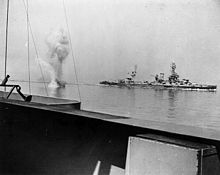| Bombardment of Cherbourg | |||||||
|---|---|---|---|---|---|---|---|
| Part of World War II, Operation Neptune–Operation Overlord | |||||||
 A heavy German coast artillery shell falls between USS Texas (background) and USS Arkansas while they duel with Battery Hamburg | |||||||
| |||||||
| Belligerents | |||||||
|
|
| ||||||
| Commanders and leaders | |||||||
|
|
| ||||||
| Strength | |||||||
|
3 battleships 2 heavy cruisers 2 light cruisers 11 destroyers 3 minesweeper squadrons |
20 casemated batteries Battery Hamburg German "fortress" status elements of 4 divisions | ||||||
Cherbourg-Octeville, a commune on the Cotentin peninsula in the Manche department of Lower Normandy, in north-western France. | |||||||
The bombardment of Cherbourg took place on June 25, 1944, during World War II, when ships from the United States Navy and the British Royal Navy attacked German fortifications in and near the city, firing in support of U.S. Army units that were engaged in the Battle of Cherbourg. In doing so, the Allied naval forces engaged in a series of duels with coastal batteries and provided close support to infantry as they fought to gain control of the city. The bombardment was initially scheduled to last just two hours but it was later extended by an hour to support army units attempting to break into Cherbourg's city streets. After the bombardment, German resistance lasted until June 29, when the port was captured by the Allies. Afterwards, the task of clearing the port for use lasted several weeks.
When the Allies secured a bridgehead in the Normandy landings, the Germans adopted a strategy to bottle up the Allied forces in Normandy and deny them the nearest major port at Cherbourg to starve them of supplies. By mid-June U.S. infantry had sealed off the Cotentin Peninsula, but their advance had stalled and the Germans began to demolish the port's facilities. In response, the Allies renewed their efforts to capture the city, and by June 20 three infantry divisions under General "Lightning Joe" Collins had advanced within a mile of German lines defending Cherbourg. Two days later, the general assault began and on June 25, a large naval task force began a concentrated bombardment of the town to help neutralize the threat of German coastal artillery and to provide support to the assaulting infantry.
The task force was divided into two groups, each consisting of a variety of warships including battleships, cruisers, destroyers and minesweepers. Each ship was assigned a series of land-based targets. German shells were accurate out to 15,000 yd (14,000 m), and in some cases they were able to bracket the radically maneuvering ships. Several Allied ships were holed, but faulty ammunition hampered German efforts. In several encounters, after being hit the heavy ships were able to withdraw after Allied destroyers obscured them with smoke.
After the action, Allied reports agreed that the most effective aspect of the bombardment was the fire that was provided by the small ships. Under the direction of army spotters, these ships were able to engage point targets up to 2,000 yd (1,800 m) inland, which proved invaluable in providing close support to the assaulting Allied infantry. In contrast, while the force's heavy guns disabled 22 of 24 assigned navy targets, they were unable to destroy any of them and, consequently, infantry assaults were required to ensure that the guns could not be reactivated. When the city fell, the neutralized casemated guns, which the Germans could have turned inland towards advancing Allied troops, were still aimed out to sea.
